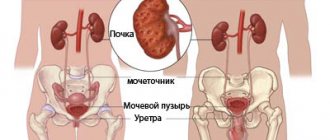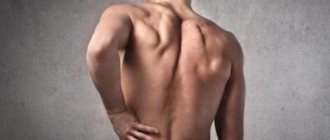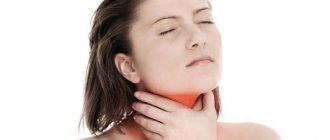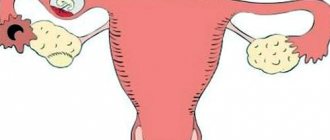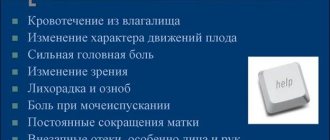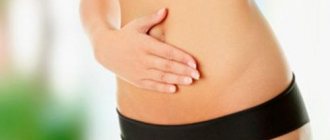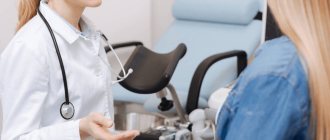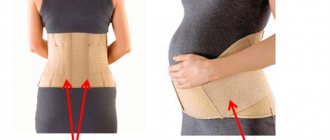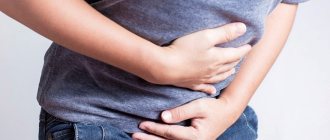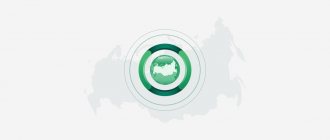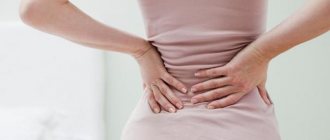The article was prepared by a specialist for informational purposes only. We urge you not to self-medicate. When the first symptoms appear, consult a doctor.
The pain that a person experiences in the lower abdomen and lower back can be caused by both acute and chronic diseases. These unpleasant, and sometimes unbearable, sensations can be of different types. The acute form of the disease (bleeding, perforation, rupture of an organ), as a rule, occurs with very severe and sharp pain. Dull, nagging or constantly aching pain is more often observed with chronic inflammation. Throbbing pain may be a sign of increased intracavitary pressure. An accurate diagnosis can only be made by a qualified specialist after a medical examination and diagnostics.
Painful sensations in the lower abdomen and back at the same time can be symptoms of the following diseases:
- Appendicitis. Inflammation of the appendix is often accompanied by chills, nausea and vomiting. Pain from appendicitis can radiate to any area of the abdominal cavity, as well as to the lower back. Painful sensations are not only acute, but also dull and aching.
- Urinary system infections. These include cystitis, pyelonephritis, urethritis. The causative agents of the diseases are mycoplasma, ureoplasma, chlamydia, gonococcus, and klebsiella. When the bladder becomes inflamed, there is an increase in the frequency of urination. These diseases can be characterized not only by pain, but also by the presence of blood in the urine.
- Intestinal infections. In the first stages of the disease, a dull, non-localized pain covers the entire abdomen. It then concentrates in the lower abdomen and radiates to the lumbar region of the back. There may be mucous and bloody inclusions in the stool. Often the causative agent of such a bacterial infection is salmonella. Medical assistance in case of this disease is urgently needed, since sepsis is possible if you contact a doctor too late.
- Colitis. Associated symptoms include fever and flatulence. The disease begins with an acute phase and after a few days can become chronic. The acute pain is replaced by a dull one.
- Inguinal hernia. Protrusion under the skin and pinching of an internal organ (or part of it) by the muscles causes very acute pain that can even lead to fainting. There may be nausea and vomiting. A person with this disease needs emergency medical care.
- Urolithiasis disease. The pain can be periodic and dull, or it can be constant and very sharp (when the stone moves). Its localization is often noted in different parts of the abdomen and lower back.
- Osteochondrosis. Destructive changes in the lumbar vertebrae cause pinching of the nerve roots, thereby causing disruption of the innervation of the organs. The main pain is localized from the back, but it can radiate to the groin area and legs.
- Malignant tumors. The considered pain options may be symptoms of cancer of the genitourinary and digestive systems.
Diseases that cause lower back pain and pulling in the lower abdomen
The nature of the pain can be completely different - from sharp cutting to moderate pulling. Each condition characterizes a particular disease. Delay in visiting a neurologist
It’s not worth it, because this is fraught with complications and the development of chronic diseases, which will make it very difficult to cure them. Among other things, some diseases that cause stomach and back pain cannot be delayed and require urgent, qualified help.
Appendicitis
Acute inflammation of the appendix is a condition in which the lower abdomen, lower back and back often hurt, and vomiting often occurs. The pain syndrome is sometimes so severe that the patient loses consciousness. Appendicitis requires urgent surgical intervention.
Oncological diseases
The reason for the pulling in the lower abdomen and lower back pain may be the development of a tumor. This is due to the fact that the tumor, growing, puts pressure on neighboring tissues, which is why pain occurs.
Intestinal infections
If you have an infection, pain in the abdomen and back will be accompanied by severe intestinal upset, and the presence of mucus and traces of blood will be noticed in the stool. This condition, in addition to pain, is characterized by intoxication of the body, weakness, vomiting and many other manifestations.
Diseases of the musculoskeletal system
Pain in the lower back, back and lower abdomen is often associated with diseases of the spine. When a person develops osteochondrosis, a hernia, scoliosis or other diseases, irradiation can occur in the stomach and throughout the back, which is explained by the plexus of nerves responsible for sending impulses to the muscles of the abdomen and lower back.
Conservative treatment of low back pain
Initially, almost all patients are prescribed conservative therapy for diseases that cause low back pain. But, unfortunately, sometimes men make the disease so severe that when it does force them to see a doctor, the only way to correct the situation or at least improve it is through surgery. Therefore, it is important to contact a chiropractor, neurologist or vertebrologist as early as possible, before the existing disease has time to lead to the development of complications or irreversible consequences.
As a rule, men are prescribed complex treatment, the main components of which are:
- drug therapy;
- manual therapy;
- massage;
- individual sessions with a rehabilitation specialist;
- physiotherapy.
The complexity and duration of treatment for low back pain depends on the stage of development of the disease and the presence of concomitant disorders. But it is always aimed at reducing discomfort and eliminating the causes of its occurrence, that is, both symptomatic and etiotropic therapy is carried out.
To increase the effectiveness of treatment, men are advised to reconsider their lifestyle:
- give up fatty foods and reduce weight as much as possible if you are obese;
- increase the level of physical activity during “sedentary” work;
- avoid overstraining the lumbar spine;
- to refuse from bad habits;
- eat so that the body receives all the nutrients it needs.
Sometimes a chiropractor may recommend that a man purchase a special orthopedic lower back brace. It will help reduce the load on the spine and create optimal conditions for the restoration of its structures.
Treatment tactics are selected strictly individually depending on the diagnosis.
Expert Opinion of a Doctor
At the first pain in the spine, you should consult a doctor at a clinic or an appropriate specialized medical center. Under no circumstances should this situation be left to chance. Remember that damage to the spinal motion segments can lead to segmental disorders of the spinal cord, deterioration of the peripheral blood supply to organs and systems in the male body, in particular, blood supply to the pelvic organs, which ultimately leads to decreased libido, impotence and even disability .
Personal: Bogdan Viktorovich UdovenkoOrthopedist, chiropractor, vertebroneurologist, osteopathExperience: More than 20 yearsAsk a question
Drug therapy
Drug treatment is aimed at eliminating lower back pain, as well as eliminating the inflammatory process and activating regenerative processes. Therefore, it is selected separately for each patient. Most often, men are prescribed:
- NSAIDs are drugs with anti-inflammatory and analgesic properties, produced in the form of drugs for oral administration, injection solutions, topical agents, and rectal suppositories;
- corticosteroids are drugs with pronounced anti-inflammatory activity, which are preferably administered parenterally and in short courses to avoid the development of severe side effects;
- muscle relaxants - medications that help relax overly tense (spasmodic) muscles and, consequently, reduce pain;
- chondroprotectors are drugs aimed at activating the restoration of cartilage tissue, but giving positive results only when used at the very first stage of the development of osteochondrosis. To prevent diseases of the musculoskeletal system, we recommend to our patients the most effective drug Mermaids Marine Collagen;
- B vitamins - used to improve the quality of transmission of nerve impulses from the spinal cord to internal organs;
- Vitamin D is a remedy responsible for the condition of bone tissue, as well as for higher brain functions, such as memory, memory, attention, and speech.
In case of particularly severe pain, injections of anesthetic solutions (Lidocaine, Novocaine) with corticosteroids can be performed in the area where the nerves pass, i.e., blockade. But such procedures, especially if performed incorrectly, can cause nerve damage and the development of serious complications.
Manual therapy
Manual therapy can be considered the basis for the treatment of spinal diseases, especially when carried out according to Gritsenko’s original method. With its help, it is possible to solve a lot of problems with the spine and internal organs, since the use of special techniques and methods allows:
- normalize the position of the vertebrae and the distance between them, which reduces the load on the discs and creates conditions for their full recovery;
- release the nerve roots, which eliminates acute pain and radicular syndrome;
- eliminate functional blocks, relax spasmodic muscles and tone overly relaxed muscles, which improves mobility;
- improve blood circulation and tissue nutrition, which ensures the delivery of all necessary substances to damaged anatomical structures and the rapid removal of metabolic products from them;
- activate natural defense and restoration mechanisms.
This is why after a course of manual therapy sessions the pain goes away for a long time and does not return for a long time. We do not have general standards of treatment; we apply an individual approach to each patient. With the help of special techniques of the Gritsenko method, it is possible to achieve activation of the body’s natural regeneration processes. Therefore, very often it is possible not only to slow down the progression of osteochondrosis or other spinal pathology, but also to achieve a complete recovery, especially when treated as soon as possible after the onset of attacks of lower back pain.
Exercise therapy
Physical therapy is an important component of the fight against lower back pain. An individually developed set of exercises, if performed daily, will help strengthen the back muscles and avoid atrophy of the leg muscles. This will create full support for the spine and help stop the progression of pathological changes in it.
The program is developed by a rehabilitation doctor for each man separately, taking into account the diagnosis, age, presence of concomitant diseases, and level of physical fitness. The first classes are conducted under the supervision of a specialist, and only after 100% mastery of the correct technique for performing each proposed exercise is it possible to perform them independently at home.
Physiotherapy
Properly selected physiotherapeutic procedures help increase the effectiveness of therapy for low back pain in men. In most situations, sessions like this are indicated:
- electrophoresis;
- laser therapy;
- ultrasound therapy;
- traction therapy (spinal traction);
- UHF, etc.
Thus, lower back pain in men can have various causes. And since most often their role is played by pathological changes in the initial stages, it is worth immediately making an appointment with a vertebrologist. This will help to diagnose deviations from the norm in the condition of the spine at the very first stages of development and completely eliminate them using conservative methods in the shortest possible time. Otherwise, the man will experience deterioration in health, complications, and in especially advanced cases, surgery.
Lower back pain and pulling in the lower abdomen in women
A woman’s body is subject to constant influence of hormones, changes in hormonal levels and some kind of “shocks”. Because of this, women often experience such an unpleasant symptom as pain in the lower abdomen on the left or right and in the lower back. It is worth understanding why pain may occur and what to do in this situation.
Diseases of internal organs
Diseases of the pelvic organs, for example, adnexitis ( inflammation of the appendages
), often accompanied by pain in the lower abdomen and lower back. Along with the pain, there is an increase in temperature and a deterioration in general well-being. The stomach and lower back can also be pulled due to infectious diseases such as colpitis, vulvitis, trichomoniasis, candidiasis, etc.
During menstruation
If during menstruation the lower abdomen and lower back hurt greatly, this does not necessarily indicate the presence of abnormalities. During menstruation, the uterus expands, which puts additional strain on the back muscles, and contractions of smooth muscles can cause the stomach to ache. To exclude the possibility of diseases manifesting in this way, you should consult a doctor, and if he is convinced that everything is in order, you can relieve pain during menstruation yourself with the help of analgesics.
Oncological diseases
Often an unpleasant symptom with pain in the abdomen and back overtakes women due to the development of oncology of the ovaries, uterus or cervix. To eliminate this possibility, you need to regularly visit a gynecologist.
for routine examinations, and also not to miss alarm bells from your body.
Ectopic pregnancy
Pain in the lower abdomen and back in the lumbar region often occurs if, after pregnancy, the fertilized egg ends up in the fallopian tube and not in the uterus. This phenomenon is not uncommon, and untimely contact with a doctor can cause a pipe rupture and the death of a woman. If your stomach and back hurt, and at the same time you have a delay, do not hesitate to visit a gynecologist!
Description of symptoms
Pain is, first of all, a signal from the body. When experiencing pain, a person understands that atypical processes are occurring in his body that the immune system cannot cope with on its own.
That is why, at the first appearance of pain, you should contact a specialist and undergo a full diagnosis.
The most common symptoms accompanying pain in the lower lumbar region are:
- Bloating. This symptom is most often observed with intestinal dyspepsia and accompanies disturbances in the gastrointestinal tract. The symptom is increased gas formation and is felt as pressure (sometimes painful) in the lower abdomen. Unpleasant sensations decrease or disappear as a result of flatulence or belching.
- Sharp pain. Patients describe this symptom as quickly occurring sharp impulses in any part of the body. Shooting pain can also be classified as sharp. Often such pain is short-lived: if it becomes prolonged, the patient loses the ability to perform normal daily activities.
- Aching pain. This type of sensation can be called slow pain. It doesn't go away for a long time, but sometimes it recedes. The person may feel painful pulsations. Often the dulling of pain is perceived by a person as the elimination of the problem, but over time the pain appears again.
- Nagging pain. Like aching, it is protracted. With nagging pain in the lower back, a person may feel a “heaviness” of the tailbone. Such sensations usually radiate in waves from the back to the buttocks.
- Girdle pain. Can be described as a circular pain, in which unpleasant sensations are felt both at the epicenter of the pain and around it.
- Constant pain. Unlike prolonged or short-term pain, such pain always accompanies the patient, stopping extremely rarely or never stopping.
The most common visits to the doctor are related to acute pain. This is explained by the fact that aching, albeit regular, pain is perceived by people not as a sign of serious abnormalities, but as an isolated incident. However, such symptoms may indicate the presence of a pathogenic process.
Causes of pain in men
“It hurts in the lower abdomen, lower back and right side” - men often go to the doctor with such complaints. To understand what caused it, it is worth considering the cases in which such a symptom appears.
Prostatitis
Prostatitis
differs not only in that it pulls the lower back on the right and the stomach, but also in some other symptoms. For example, a man notes a burning sensation when visiting the toilet, as well as problems with erection. The cause of the disease is often stagnation of capillary blood, as well as the effect of bacteria on the body.
Bacterial infections
If unpleasant symptoms appear, when there is pain in the lower abdomen and lower back, the problem may lie in the penetration of pathogenic bacteria into the body. Bacteriological causes of pain are considered quite common. For example, stomach and back pain occur due to sexually transmitted diseases. In this case, a man may notice uncharacteristic discharge from the urethra, redness of the penis, impaired sexual function, etc.
Orchiepididymitis
It is an inflammation of the testicles, which can develop against the background of surgical interventions in the body, be a consequence of injuries or sexually transmitted diseases. In addition to abdominal and lower back pain, the man suffers from headaches, chills, nausea, and a fever.
Inguinal hernia
If the lower back hurts badly, and the pain radiates to the lower abdomen, and the pain itself is sharp and even unbearable, the cause may lie in an inguinal hernia. Sometimes hernia pain is even stronger than with appendicitis, and the patient has no choice but to call an ambulance.
Colitis
It is a pathology of the duodenum, or more precisely, an ulcer. The acute period of the disease lasts about a week, after which it becomes chronic, and the man constantly feels pain in the back and abdomen.
Spine pathologies
One of the most common causes of lumbar pain is pathological processes in the spine. Typically, such diseases cause sharp or aching pain localized in the spinal column itself. But sometimes pain along the nerve roots spreads to the sides and into the abdominal cavity. This is usually caused by pathologies that lead to displacement of the vertebrae or damage to the intervertebral discs. In this case, pinching of nerve fibers occurs, which becomes a source of pain.
There are few such pathologies, but recently they have become more common. A sedentary lifestyle, poor diet, a lot of stress and excessive physical activity - all this adversely affects the health of the spinal column. It is impossible to independently determine why the pain occurred.
Often the cause of such pain is pathology of the lumbar spine.
Therefore, it is necessary to undergo a differential examination, during which the doctor will detect one of the pathologies.
Osteochondrosis of the lumbar spine is characterized by the destruction of cartilage tissue. As a result, the vertebrae move closer together, which can lead to pinched nerve fibers. This causes sharp pain that can spread to the sides.
Herniated discs in the lumbar region occur frequently, since the lower back is subject to increased physical stress. When a disc ruptures or bulges, the nerve roots are pinched or damaged.
Radiculitis or inflammation of the spinal nerve roots appears after sudden heavy lifting, unusual physical activity or hypothermia. The pain is localized in the lumbar region, but can spread to the sides, abdomen, groin and even legs. It is accompanied by radicular syndrome: numbness of the lower extremities, a feeling of goosebumps, decreased sensitivity, and muscle weakness.
What to do in case of acute pain
When the lower abdomen and lower back hurt, we often start looking for reviews from other people who have already encountered such a situation in order to understand the reason and determine the course of action for ourselves. It is worth understanding that it is unlikely that you will be able to make an accurate diagnosis for yourself; here you need to immediately seek qualified help from specialists. If the pain is acute and sharp, it is best not to hesitate and call ambulance workers so that you can be examined and brought to the clinic as soon as possible for diagnosis and diagnosis. After this, you will be prescribed treatment, and you can expect an improvement in your condition.
Types of lower abdominal pain
The nature of the pain may vary:
- pulling;
- pricking;
- aching;
- cramping;
- bursting;
- blunt;
- cutting;
- encircling;
- burning, as if burning from the inside.
Unpleasant sensations can begin abruptly and intensely, increase gradually, disturb the right, left or middle, radiate to the lower back and other areas. It can last for several minutes or days, stop intermittently or be constant.
The causes of lower abdominal pain in women can be divided into several main categories:
- physiological, caused by changes in the body;
- gynecological diseases;
- problems in the urinary system;
- disorders of the functioning of the intestines and diseases of the digestive system;
- other pathologies and conditions.
In choosing specific research methods and making the correct diagnosis, clarifying the nature, duration, and intensity of pain is of great importance. By studying the symptoms, doctors can assume a certain disease and outline the necessary direction in examining the patient.
Which doctor should I contact?
To find out the reasons why the lower back and stomach hurt, you need professional intervention, examination by a doctor and modern diagnostics. To understand who to contact, you should pay attention to the symptoms associated with pain. If, in addition to an aching stomach, there is discharge from the genitals and disruptions in the reproductive system, a gynecologist or andrologist will help you. For pain in the back and abdomen with numbness of the limbs, a neurologist should come to the rescue. If you are faced with such a problem for the first time, then the right solution would be to visit a therapist. His specialization will allow you to determine which specialist to refer you to for a detailed examination, diagnosis and treatment when your lower back, buttocks and lower abdomen hurt.
Diagnostics
If girdling pain occurs under the ribs and in the back , an immediate consultation with a gastroenterologist is recommended to conduct a differential diagnosis and identify the cause of the ailment. A general examination is prescribed, including the following activities:
- esophagogastroduodenoscopy;
- ultrasound examination of the abdominal organs;
- general blood analysis;
- biochemical blood test;
- general urine analysis;
- analysis for Helicobacter pylori infection.
Digestive problems
Pain in the lower abdomen may also occur due to problems with the intestines or existing diseases of different parts of the digestive system:
- Poisoning from low-quality food contaminated with bacteria. For example, with shigellosis, eschirichiosis and other infections, the pain is paroxysmal and pronounced.
- Hernias of inguinal, Spigelian and white lines. When they are pinched, acute painful sensations occur in the abdominal cavity.
- Pancreatitis. When the pancreas is inflamed, the left side of the lower abdomen and chest hurts, and jaundice may occur.
- Intestinal colic. Characterized by spasm of the large or small intestine. It can be the result of helminthic infestation, food poisoning, or severe stress.
- Cholecystitis. When the flow of bile is disrupted, the risk of developing gallbladder inflammation is high. In this case, the pain spreads to the right side, shoulder or shoulder blade.
If pain occurs accompanied by diarrhea or constipation, changes in the color of stool, the appearance of blood or mucus in the stool, bloating, nausea, vomiting, frequent bowel movements, chills or fever, the cause of such symptoms may be a disorder of the digestive function, organ diseases Gastrointestinal tract.
How to relieve constipation pain
Since the cause of pain is constipation, by eliminating it, you can get rid of the unpleasant or painful sensations that accompany it. In the process of treating bowel disorders, you should follow several simple rules that will help both in the fight against constipation and in relieving pain:
- exclude from your diet foods that stimulate the formation of gases in the intestines (legumes, brown bread, whole milk, fresh cabbage, carbonated drinks, etc.);
- remove from the menu or minimize foods that have a fixing effect (chocolate, rice, potatoes, blueberries, hard-boiled eggs);
- follow the principles of fractional nutrition: eat at least 5-6 times a day in small portions. This will ensure an even flow of food into the gastrointestinal tract and reduce pain caused by stretching of the intestinal walls;
- Make it a habit to take daily walks or do 5-10 minutes of exercise in a ventilated room. Even such mild physical activity will improve intestinal motor function and relieve pain caused by cramps.
Up to contents
